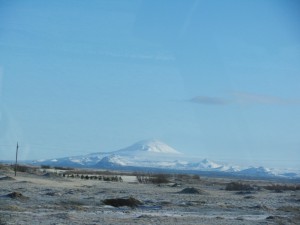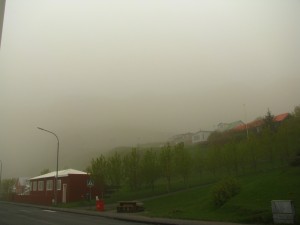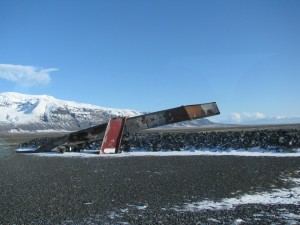When the volcanoes wake up. Posted by hulda on May 16, 2012 in Icelandic culture, Icelandic customs, Icelandic history
 As the weather gets warmer yet another very Icelandic feature begins to take place when eldfjöll, the volcanoes, begin to show more signs of life when the layer of ice on top of them grows lighter in weight or disappears altogether depending on whether the volcano is beneath a glacier or not. At the moment the most interesting ones are no doubt Hekla (shown in the first photo; the origin of the name is unclear but it could have once meant a comb) and Katla (= kettle), sister to Eyjafjallajökull (= Island-mountains -glacier), the famous one that caused much trouble to air traffic in the spring of 2010. Katla tends to erupt shortly after Eyjafjallajökull so no one in Iceland will be too surprised when that happens. Hekla erupts fairly often and is now a little bit overdue, but luckily she doesn’t usually cause much damage.
As the weather gets warmer yet another very Icelandic feature begins to take place when eldfjöll, the volcanoes, begin to show more signs of life when the layer of ice on top of them grows lighter in weight or disappears altogether depending on whether the volcano is beneath a glacier or not. At the moment the most interesting ones are no doubt Hekla (shown in the first photo; the origin of the name is unclear but it could have once meant a comb) and Katla (= kettle), sister to Eyjafjallajökull (= Island-mountains -glacier), the famous one that caused much trouble to air traffic in the spring of 2010. Katla tends to erupt shortly after Eyjafjallajökull so no one in Iceland will be too surprised when that happens. Hekla erupts fairly often and is now a little bit overdue, but luckily she doesn’t usually cause much damage.
A small scale jökulhlaup, a glacier flood, began near Katla on the 28th of April and it’s still continuing. This is often a sign of the volcano underneath the ice growing warmer and the local specialists seem to agree the flood water has indeed been melted by volcanic activity. As volcanoes are unpredictable this does not necessarily mean an eruption, or that it would be a large one. It could be just like the one last year when Katla‘s eruption was so small that it went mostly unnoticed by the rest of the world. Still, it pays to be careful because Katla is considered one of the most dangerous volcanoes on Iceland and therefore Icelanders are keeping an eye on her at the moment.
But what is it that makes her so noteworthy and does the rest of the world need to be prepared? The answer to the latter question is yes and no. Katla will unlikely cause any noteworthy damage to countries other than Iceland, but just like her sister she’s very capable of halting the air traffic. This is because Katla is located under Mýrdalsjökull (= Bog valley glacier) and subglacial volcanoes produce high amounts of ash. Secondly her ash is the light kind just like Eyjafjallajökull’s and stays in the air for a long time. To compare, the eruption of Grímsvötn (a subglacial lake possibly named after Vestfjarða-Grímur, Grímur of the west fjords) in 2011 did not cause half as much trouble even though the eruption was larger in comparison. The reason it only halted air traffic for four days (Eyjafjallajökull kept planes down for six days in April and some more again in May) was that the ash of Grímsvötn volcano was the heavier kind and rained down faster.
 None of this makes an Icelander panic. Volcanoes erupt here all the time and the locals are well used to them. The worst damage the ash causes is to the farmers who live in the nearby area since they risk losing their livestock. If the sheep aren’t quickly gathered indoors they will eat grass covered in poisonous ash and die, and gathering them is easier said than done since they roam free in the mountains for the whole summer. The rest of the population simply stays indoors as much as they can, put tape around their windows to stop the ash from coming in and then clean it away from their property quickly. Other possible activities include going to see the eruption from as close as possible, eating picnic where you can see the magma fly up in the air and start a small scale restaurant in the area, cooking in the hot soil.*
None of this makes an Icelander panic. Volcanoes erupt here all the time and the locals are well used to them. The worst damage the ash causes is to the farmers who live in the nearby area since they risk losing their livestock. If the sheep aren’t quickly gathered indoors they will eat grass covered in poisonous ash and die, and gathering them is easier said than done since they roam free in the mountains for the whole summer. The rest of the population simply stays indoors as much as they can, put tape around their windows to stop the ash from coming in and then clean it away from their property quickly. Other possible activities include going to see the eruption from as close as possible, eating picnic where you can see the magma fly up in the air and start a small scale restaurant in the area, cooking in the hot soil.*
What does make even the locals vary are actually the jökulhlaups. Even a small one can cause considerable damage like last year’s flood that washed away several kilometres of Ring road 1 and the bridge over Múlakvísl, breaking the most important connection of the island for days. A large one would be absolutely devastating: just look at the map of south Iceland. There, underneath the largest group of glaciers are Mýrdalssandur (= Bog valley sand) and Skeiðarársandur, (= Spoon river sand) two large, flat wastelands where nothing grows besides grass. At every jökulhlaup in this area Iceland grows a little in size due to the amount of soil the floods carry with them to sea. The Ring road 1 is particularly vulnerable in this area.
 All that remains of a whole bridge after a jökulhlaup in Skeiðarársandur.
All that remains of a whole bridge after a jökulhlaup in Skeiðarársandur.
Besides that there are many farms and cities around this area. Katla’s earlier eruptions have swept whole farms away so that nothing of them remained. In the last large scale eruption whole peaks of ice sailed along with the flood and this was by far not the first time is sagas are to be trusted. In 1311, the history goes, a farmer named Sturla managed to save himself and his small son by clinging onto an iceberg than was later carried back ashore. Another country legend*** says that four US soldiers were caught in one such flood in 1996 while crossing a bridge in a car and have never been seen again.
So what should people do while waiting for Katla or Hekla to erupt again? Nothing much, unless you’re a volcano enthusiast or a geologist in which case you might like monitoring what’s going on for your own amusement. There are many ways of doing this but the easiest is probably to simply follow the very informative and often updating Iceland volcano and earthquake blog, written by Jón Frímann. Earthquakes, or jarðskjálftar, can be followed on the official page of Vedurstofa Íslands. For the rest of the world I suppose the only advice I can give is that there will always be more flights, and that no one can help it if a volcano on some random island burps up a huge cloud (I love how dramatic the narrator makes the halting of air traffic sound like).
*All were done during the Eyjafjallajökull eruption. Only three people died, far as I remember.**
**They got lost in a snow storm.
***This one has never been confirmed by any office, mind.

Build vocabulary, practice pronunciation, and more with Transparent Language Online. Available anytime, anywhere, on any device.
About the Author: hulda
Hi, I'm Hulda, originally Finnish but now living in the suburbs of Reykjavík. I'm here to help you in any way I can if you're considering learning Icelandic. Nice to meet you!



